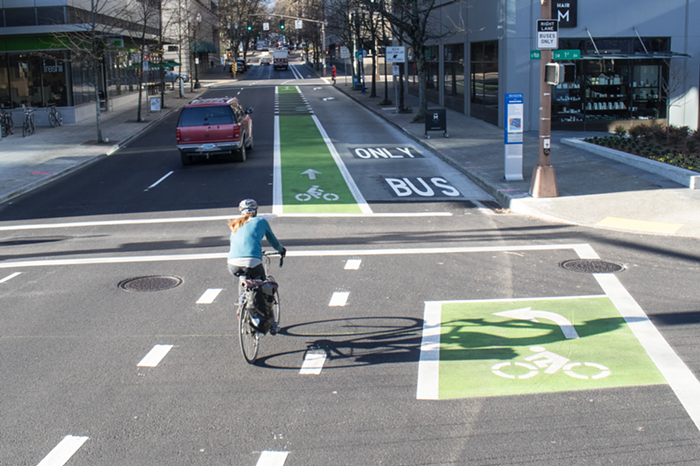Mysterious and stimulating, Oregon's ghost towns offer a voyeuristic peek into the past, reveal the leftovers of human greed, and prove nature's desire to reclaim itself.
GETTING THERE
Sure, you could take the highway to the desert and start walking in hopes of finding a ghost town, but there are better ways. I like to buy outdated gas station maps found at thrift stores, and compare them to modern maps. Whatever towns are missing on the new ones are usually ripe for exploration. Get a map! Buy a book! Take a drive!
Planning and executing Oregon ghost town road trips is 'tard-simple, especially if you plan "loop excursions" (where you pick a central location to stay at and hit the real ghost towns during the day), which focus on relatively small areas, but can be plotted to individual taste.
No matter where your base camp is, be sure to talk with some of the locals before setting out. Ask what's around. Any hanging trees? Gold mines? They know a lot about the lay of the land, including where unmapped ghost towns are and current info like what back roads are washed out, and which landowners shotgun trespassers.
Most ghost towns west of the Cascades are going to be skeletons of stone and masonry due to high moisture saturation. Wood doesn't stand a chance in those conditions. East of the Cascades it's drier, and while some stone and brick structures still abound, a lot of old wooden buildings that have managed to survive high winds and fires still remain. Some still have a few stragglers living there, keeping the faith.
No trip will be perfect. All ghost towning trips verge on the uncomfortable side. Bite the bullet and get over it. In addition to sore feet from hiking, I always get a strange sensation when I enter a true ghost town. They evoke great feelings of somber failure, but failure that wasn't devoid of promise. These were boomtowns in their day, crammed full of drunken entrepreneurs and dirty dealers. Back then, if someone found gold or another commodity, they threw a town up, got drunk, milked it until it was gone, then cleared the hell out.
Most of these towns were built at the spur of the moment, and were never intended to last. Often, someone would discover a resource like water, gold or silver, then build a boarding house (where they could also keep an eye out for Indian attacks), a few saloons, and an outhouse, and build the rest of the town at their leisure. Some towns went up simply as waypoints between other small boomtowns, and when the booms bombed, they disappeared just as quickly as the source towns.
Oregon ghost towns are small compared to some in California, Nevada, and elsewhere. But the psychic isolation of a smaller town makes it more mysterious. Who sat here? Who died there? What's that smell? And it's slow going. You can't rush it. Floors will give way. Walls cave in. Doors are open or gone. Furniture and clothing has turned to dust. There are no plaques to commemorate anyone.
While ghost towning hundreds of miles from a roaming signal, I've been surprised by stray dogs, explosions of freaked-out chickens, startled wildlife, coyotes, elk, snakes, and birds of prey. In some buildings, every available surface is carpeted in human, rodent, pigeon or bat feces--scoop some of that up and put it on your pancakes.
WHERE TO BEGIN
The historic sheep town of Shaniko, located only 130 miles from Portland, is a great starting point for greenhorns. Drive east up the Columbia Gorge to Biggs, get a beer at the Chevron, and turn south on Highway 97. Shaniko is about 60 miles south of Biggs. It's not a true ghost town, but it's a nice central hub near a lot of real ones in a tri-county area (Sherman, Wasco and Wheeler Counties). Other hub towns exist throughout the state.
Claim to fame? Shaniko was once the "Wool Capital of the World." Peak years were between 1900-1911. Range wars were fought there between sheep ranchers and cattle ranchers over grazing land and water rights. The Columbia Southern Railroad shot straight through town until it became obsolete. Back in the day, Shaniko had five saloons and three full-size hotels. In 1904, the town's revenues exceeded $5 million in a single day, a fortune at the time.
Today, one hotel remains, as do a few historic buildings, and a smattering of small, hokey businesses. The 1910 census reported a population of 600. Today it's 25, with eight reported "part-time" residents. The Shaniko Hotel, an elegantly restored 1900s-era brick building, has rooms for around $60 per night. There's also some kind of Bed and Breakfast, but for those with a more pioneering spirit, you can actually camp for far less.
Expect locals to eye you suspiciously as you snoop around Shaniko's remains--ragged buildings, a saloon, barns full of antique automobiles and wagons--but overall they appreciate the interest. Photo ops include downtown Shaniko, a strange old water tower, a creepy Children of the Corn schoolhouse, and a guy whose backyard has become a heaping repository for antique bottles.
SHANIKO LOOP--SUGGESTED SERVING
Day trips to Shaniko's surrounding ghost towns without any residents (except for assorted wild animals) can be accomplished in a few hours. Drive south from Shaniko to Antelope, where the Rashneeshies lived and tried to poison everyone.
East of Antelope is Fossil. People live there, too, but you can dig for 33 million-year-old fossils behind the high school. I bring an Army surplus folding shovel, dig out the rocks, and split them with a hammer to reveal the fossils.
East of Fossil, on a dirt road off of Highway 19 is Kinzua (kin-zoo), an old mill town that was "returned to the earth" in the 1970s. That means they knocked it all down. It's still a great place for bottle collectors, though, and a good place for metal detecting. If you keep going east on that dirt road, you will run into Lonerock (actually in Gilliam County), which has a fantastic graveyard with winged cherub headstones, and buildings dating back to the 1890s.
South on Highway 19 is the tiny ghost town of Richmond. There, scattered among a few barns and houses, you'll find an old school, a church, a tiny "downtown" area in disrepair, and the old Richmond General Store. There's a cemetery there, too, but I haven't found it yet. Bring a few pepperoni sticks, as there are dogs in the area that need to be bought off as you explore the town. Richmond ends at Six Gun Road. Up on the hill there is an old house worth checking into. Don't miss the "two-seater" outhouse.
Richmond is fading fast. I recently noticed entire houses were gone since my last visit.
Back on the main road, travel south from Richmond to Mitchell on Hwy 26, turn left, and go a few miles, then turn north at the John Day Fossil Beds National Monument sign. Continue north (passing Priest Hole and Painted Hills) and make a left on the road at Burnt Ranch (east toward Ashwood). This is a treacherous road in places. After 20 miles or so, you'll see a huge pile of pinkish-white pebbly rocks piled up off the road. Pull over here and park. Behind the barbed wire fence is the forgotten town of Horse Heaven, a historic mercury-mining town.
Horse Heaven looks like Kinzua used to, with many buildings set into the hills under the trees. Living quarters, small dining halls, and work buildings are still standing between original open mine shafts into the hillside, some reaching as deep as 1400 feet. There used to be ore carts and tracks, but recently someone has taken them (probably as souvenirs). I wouldn't suggest entering the mines, but that's up to you. Leave someone outside in case of a cave-in.
Overnighting inside the buildings can be fun, but expect your mercury levels to be jacked up if you do. Those pink stones are cinnabar, and were once cooked up in little vials to distill and collect the mercury from them. Near the old cookhouse thousands of the broken vials are strewn.
Continue west to Ashwood for a look at the charred boards of a gold town that burned down years ago, or turn north just before reaching Ashwood, and take the only available dirt road back up to 218, and return to Shaniko via Antelope. If you do go to Ashwood, continue to Willowdale, then points north to proceed.
Afterwards return to Shaniko to recover a modicum of civility. Or, if civility seems boring, turn where the sign says "Tent Campin'". It's located in a big field full of deer shit. Deer are there all night walking around town, so leave your pot plants and bamboo sprouts at home. Those who may be unfamiliar with the sky should also beware. Shaniko has a big one. Most months it can be hot during the day and count on it being damned cold at night.
One night that I stayed in Shaniko, around midnight, someone began tinkering with the player piano in the old saloon in town. As the honky-tonk music tinkled away under a full moon and carried across the rolling landscape, a creepy 360-degree stereo chorus of coyotes sang along.
I invented a drink while camping in Shaniko. "Shaniko Chili." It's a drink, but a food, too. Something to take the chill off and repay my bones for a hard day's work exploring ghost towns. Simply cook up a large can of Jalapeno Chili on your camp stove or Sterno Fondue pot, and add half a fifth of brandy once it boils. Shaniko Chili warms body and soul, and gives one pause for reflection (vegetarian chili and breast milk can be substituted for grazers).
BOOKER T. PANNELL
Hardcore residents in these forgotten towns are iconoclastic characters with tall tales to tell about the history and mythology of their territories. Shaniko's recently elected mayor, Booker T. Pannell, is definitely a standout. After all, he parked his vintage penguin-colored demolition-derby emergency Pontiac--smack in the middle of downtown Shaniko--long before he was mayor.
Pannell isn't a native of Wheeler County. He's only been in Shaniko for 17 years. He found the town by accident while getting lost on a fishing trip. Pannell fell for the Old West lifestyle, and since then has made a name for himself by initiating restoration financing schemes, securing a $25,000 grant for street improvements, and actually rebuilding the original Shaniko wooden sidewalks by himself while others looked on... Or so he says.
Part of his stewardship will be preserving and polishing Shaniko and making it profitable for the remaining residents, but also to slow natural decay. That's the rub. If you want real ghost towns, someone has to live there and keep them up. If you want complete isolation, expect only charred boards.
A few years ago, Shaniko had a chance to make some good money toward restoration, when a film crew wanted to use the location to shoot a western. "They wanted to put dirt on the streets," Pannell, then a city council member, said. Even though Shaniko would have been paid a lot of money, and the dirt would be all cleaned up when they left, the city council voted against it.
"I was for it," Pannell told me, "but some dumbasses threw a monkey wrench into that. They didn't want dirt in the street. I was so sick about that."
SHOOT THE SHIT
Talking to locals is the only way to get the real dirt--not only directions, but also the folk tales and historical enhancements that put a face on the past. Such was the case when I talked with the graveyard caretaker in the tiny ghost town of Mabel, which is hidden in the woods slightly northeast of Eugene near Shotgun Creek. Walking through the graves, Thompson showed me how they all pointed at an odd angle. Each body there has been given the dubious privilege of being stuck in the earth facing the site of the original mill that had once employed the entire town.
Another thing I would have missed was the dozens of Chinese mill workers buried there. Unfortunately, these dead residents had only wooden markers, which have since decomposed. Without Thompson's input, I would have been oblivious, and could have accidentally dug up a Chinese person.
OREGON GOLD
To some, staring at old buildings and collecting household trinkets seems boring. They prefer richer treasure. If you're hip to that noise, you might want to follow a different path. Oregon folklore is full of tales of mother lodes that got away, such as the infamous yet elusive Blue Bucket Mine.
In August 1845, so the story goes, a pioneer family left Boise en route to the Willamette Valley and wound up lost somewhere between the Snake River and The Dalles.
While the desperate group camped in a dry-wash ravine without water or food, their child occupied her time by filling a small bucket with knuckle-sized gold nuggets. All the while, her parents discussed the possibility of their impending doom. As they set out again, the girl brought her blue bucket along on their journey.
Preoccupied with survival, the party never bothered to look at the girl's weighty collection of shiny "toys" until they had finally made it to civilization. When they did, they rightfully shit their pants and, fully financed, set out to rediscover the rich streambed. They found it it was impossible to retrace the path of their lost ramblings, and the site was never found again. It's still out there.
Unless you're set on a particular lost mine or treasure, however, don't put all your nuggets in one bucket. Instead, plan a loop of existing mines that are in hub areas like Baker City, or Burns. There are plenty of Northwest ghost towns with rich, documented histories of flaked gold, jewelry-grade nugget deposits, and abandoned mining operations that you can actually find.
For instance, Susanville, once a booming gold town, sits between four or five forgotten mining towns that are within 50 miles of each other in Grant County. During a leisurely three-day weekend, it's possible to thoroughly explore all of them, and you may leave with pay dirt. It's happened before, and it could happen again. In 1913, George Armstrong found the largest gold nugget ever discovered in Oregon, weighing over 80 ounces. The Armstrong Nugget is still proudly displayed in Baker City, and if I were a bank robbing kind of guy, that'd be my next target.
WHEN TO GO
Late fall and winter trips can be the most uncomfortable and dangerous times to go ghost towning, but what the hell? You're young and tough, and it may be worth your extra effort. All it takes sometimes is for a little rain to wash away the topsoil and reveal gold nuggets or lost treasures. Wet earth makes it easier to dig too, especially if you're dirt fishing with a metal detector, or digging up old bottles. If it's snowing or the ground is frozen, it'll be harder, and you may wind up with cold nuggets, instead of gold.
Winter is the perfect time to research for spring and summer excursions, especially if you don't feel like roughing it during the tough seasons. Good research can make or break a trip. If, for example, you're interested in graveyards and you go to places like Shaniko, you'll be disappointed. Shaniko doesn't have a graveyard. No one has ever been buried in Shaniko because six inches below the topsoil is solid bedrock. Gear your trip to what interests you, and don't waste your time looking in all the wrong places.
WHILE YOU CAN
Unlike parks and museums, ghost towns are the last remnants of the Wild West--gunfights and whorehouses, boomtowns and obsolete industries, etc.--that we can still experience firsthand. But it isn't for everyone. It involves extensive travel over hundreds of miles of unimproved and dangerous roads. Sometimes you have to hike in.
Due to the transitory nature of ghost towns, some can completely disappear with a heavy storm or fire. Others are wiped away like names off a chalkboard, with backhoes over liability issues. The ones that remain are not clean places, and they are often repositories for abandoned garbage left over the years.
Anyone who looks hard enough will find cool stuff to bring home. On previous trips, I've collected dishware and household artifacts, even a cow skull once. Some people collect glass doorknobs or hinges. On my last trip, I came home with a dozen fossils, a brass shotgun shell casing circa 1910, a 1933 Oregon license plate, an old cork-top Jim Beam bottle, and five rolls of pictures. I also found an old slender faceted beer glass (a "dimie") that cleaned up rather well. It's beautiful in design and works just fine. Some people think you should leave everything exactly where you find it, but the way I see it, it's already history. Take what you can.
Don't set your sights too high, and chances are real good you'll bring home a quality souvenir or two. It would be irresponsible for me to not mention the fact that trespassing on private property is illegal, and to view many of the remaining ghost towns in Oregon, you have to either get prior permission from landowners, or break the law.
Personally, I rarely pass up the opportunity to explore ghost towns, whether I get permission, or ignore posts on private property and climb through barbed wire and hike. Whatever it takes, unless there's a guy standing on the other side of the fence with a loaded gun.
That's my choice. Hey, if you're into something else, do that.












